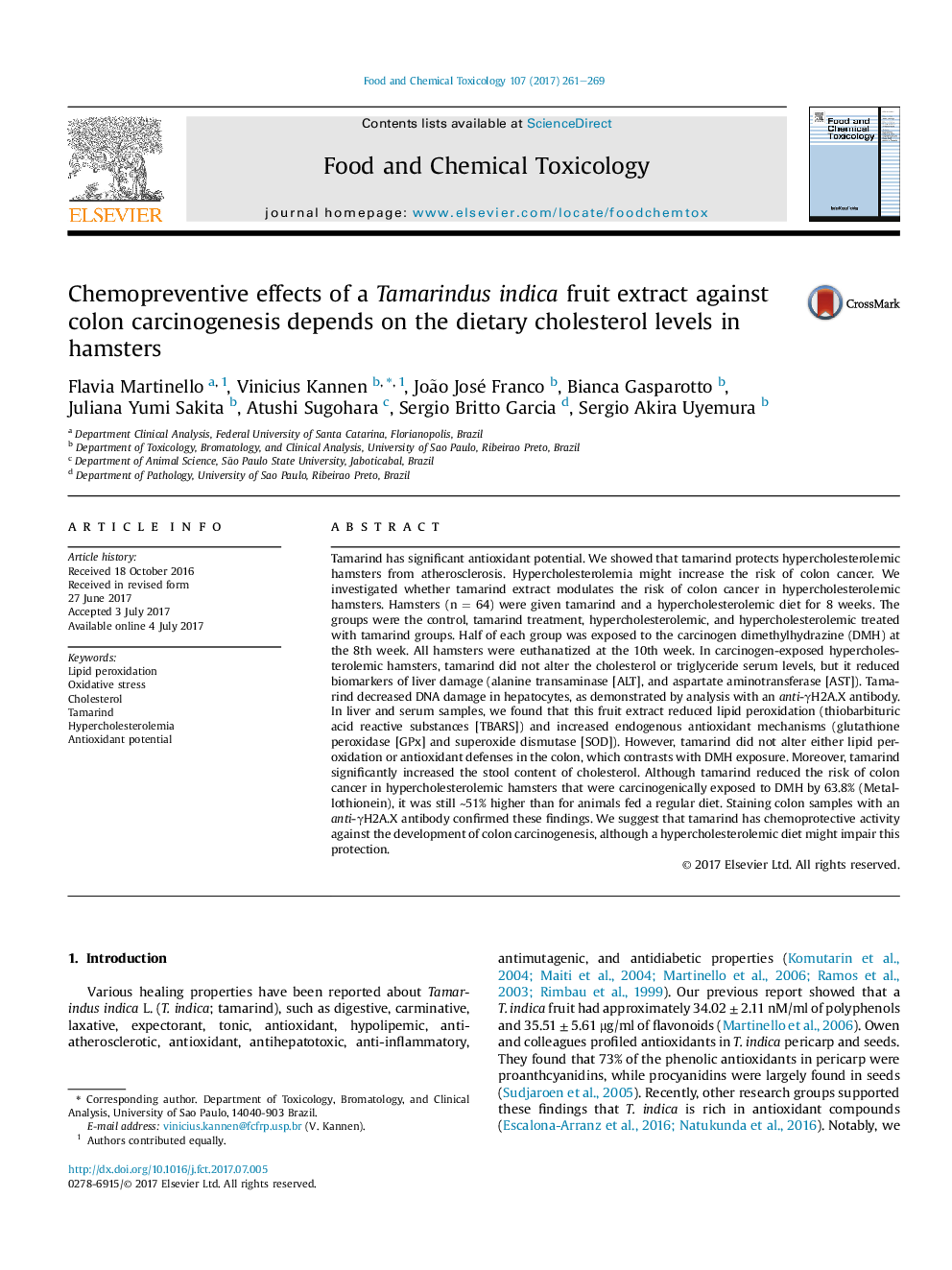| کد مقاله | کد نشریه | سال انتشار | مقاله انگلیسی | نسخه تمام متن |
|---|---|---|---|---|
| 5560080 | 1403308 | 2017 | 9 صفحه PDF | دانلود رایگان |

- Cholesterol promotes lipid peroxidation, DNA damage, and colon carcinogenesis.
- Tamarind has a significant antioxidant potential and reduces hypercholesterolemia.
- Tamarind reduced a carcinogen-related hepatic lipid peroxidation and DNA damage.
- Tamarind reduced the risk of colon cancer aside from colonic antioxidant mechanisms.
- Cholesterol impaired some chemoprotective effects of tamarind in the colon.
Tamarind has significant antioxidant potential. We showed that tamarind protects hypercholesterolemic hamsters from atherosclerosis. Hypercholesterolemia might increase the risk of colon cancer. We investigated whether tamarind extract modulates the risk of colon cancer in hypercholesterolemic hamsters. Hamsters (n = 64) were given tamarind and a hypercholesterolemic diet for 8 weeks. The groups were the control, tamarind treatment, hypercholesterolemic, and hypercholesterolemic treated with tamarind groups. Half of each group was exposed to the carcinogen dimethylhydrazine (DMH) at the 8th week. All hamsters were euthanatized at the 10th week. In carcinogen-exposed hypercholesterolemic hamsters, tamarind did not alter the cholesterol or triglyceride serum levels, but it reduced biomarkers of liver damage (alanine transaminase [ALT], and aspartate aminotransferase [AST]). Tamarind decreased DNA damage in hepatocytes, as demonstrated by analysis with an anti-γH2A.X antibody. In liver and serum samples, we found that this fruit extract reduced lipid peroxidation (thiobarbituric acid reactive substances [TBARS]) and increased endogenous antioxidant mechanisms (glutathione peroxidase [GPx] and superoxide dismutase [SOD]). However, tamarind did not alter either lipid peroxidation or antioxidant defenses in the colon, which contrasts with DMH exposure. Moreover, tamarind significantly increased the stool content of cholesterol. Although tamarind reduced the risk of colon cancer in hypercholesterolemic hamsters that were carcinogenically exposed to DMH by 63.8% (Metallothionein), it was still â¼51% higher than for animals fed a regular diet. Staining colon samples with an anti-γH2A.X antibody confirmed these findings. We suggest that tamarind has chemoprotective activity against the development of colon carcinogenesis, although a hypercholesterolemic diet might impair this protection.
The carcinogen dimethylhydrazine (DMH) is an indirect carcinogen that must be activated by the hepatic metabolism before damaging the intestinal colon. Specifically, hepatic CYP2E1 metabolizes DMH into azoxymethane (AOM), which later becomes methylazoxymethanol (MAM). Colonocytes then metabolize MAM into methyl diazonium ion, as well as methyl cation, that binds and damages DNA. We found that a Tamarindus indica fruit extract protects the colon from DMH-induced carcinogenesis promoting hepatic antioxidants mechanisms that might control the DMH-related lipid peroxidation increase. Then, cholesterol promotes colon carcinogenesis and blocks not only the benefits of tamarind in the liver but also this fruit chemoprotective effects against the development colon preneoplastic lesions.105
Journal: Food and Chemical Toxicology - Volume 107, Part A, September 2017, Pages 261-269